Abstract
The antifungal agent amphotericin B (AmB) alters neutrophil (polymorphonuclear leukocyte [PMN]) function, and this may be the mechanism for some of the adverse effects caused by AmB. AmB is a potent inhibitor of PMN migration, increases PMN adherence and aggregation, and primes PMN for increased oxidative activity in response to a second stimulus. AmB also stimulates mononuclear leukocytes (MNLs) to release inflammatory mediators which augment the effects of AmB on PMN function. In the present study, we observed that the methylxanthine derivative pentoxifylline decreased the effects of AmB on PMN function. AmB (2 micrograms/ml) priming doubled PMN chemiluminescence stimulated by fMet-Leu-Phe. In the presence of MNLs, AmB priming increased fMet-Leu-Phe-stimulated PMN chemiluminescence to 622% of unprimed PMN activity. Pentoxifylline (100 microM) blunted the rise in AmB-augmented PMN chemiluminescence in the presence of MNLs to 282% of unprimed PMN activity, and pentoxifylline metabolites were active at 10 microM. Pentoxifylline (100 microM) also blocked AmB-augmented PMN oxidative activity in whole blood, as measured by nitroblue tetrazolium reduction. In the presence of MNL, AmB (2 micrograms/ml) doubled the expression of the important PMN adherence factor Mac-1. Pentoxifylline (1 mM) decreased AmB-stimulated PMN Mac-1 expression back to unstimulated amounts. In the presence of MNLs, AmB (2 micrograms/ml) decreased PMN nondirected and directed migration to fMet-Leu-Phe to 40 and 38% of control PMN migration, respectively. Pentoxifylline (300 microM) counteracted AmB inhibition of nondirected and directed migration to fMet-Leu-Phe, resulting in migration that was 71 and 87% of control PMN migration, respectively. In contrast, the methylxanthine caffeine (100 muM) increased AmB-enhanced chemiluminescence but did not affect AmB-inhibited PMN migration. Pentoxifylline should be evaluated as adjunctive therapy to lessen the inflammatory damage caused by AmB.
Full text
PDF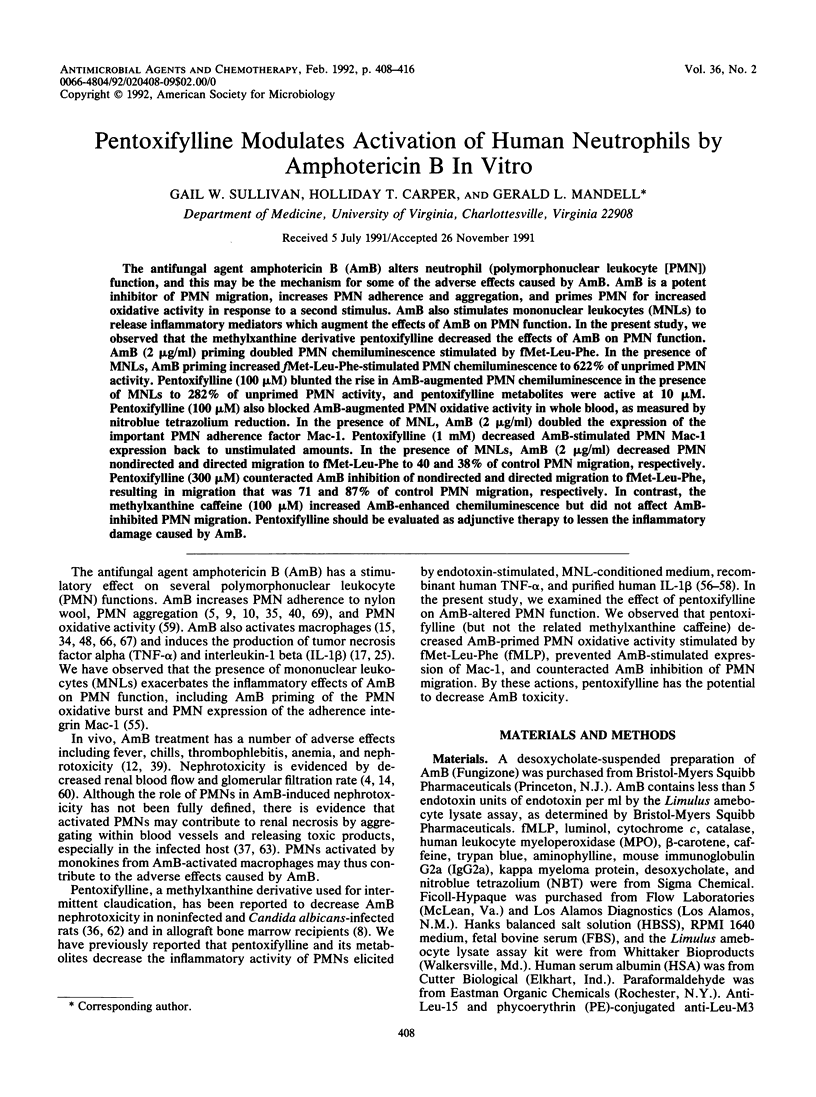
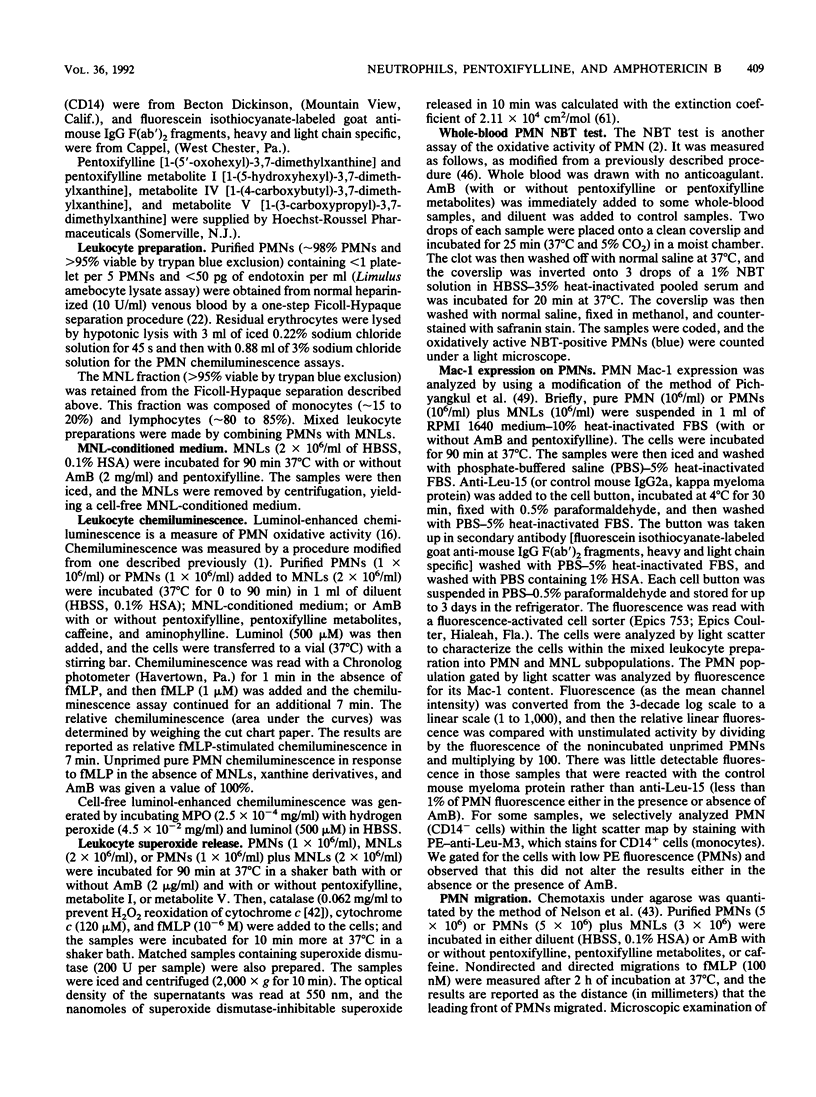
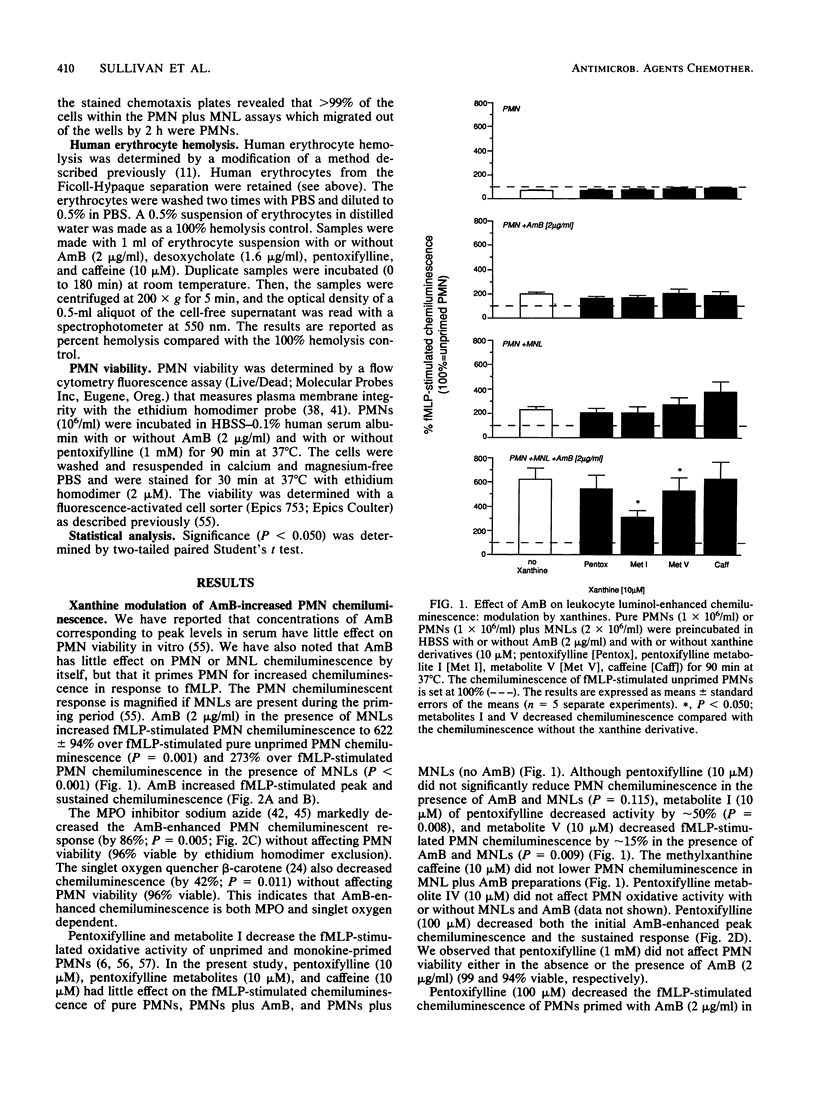
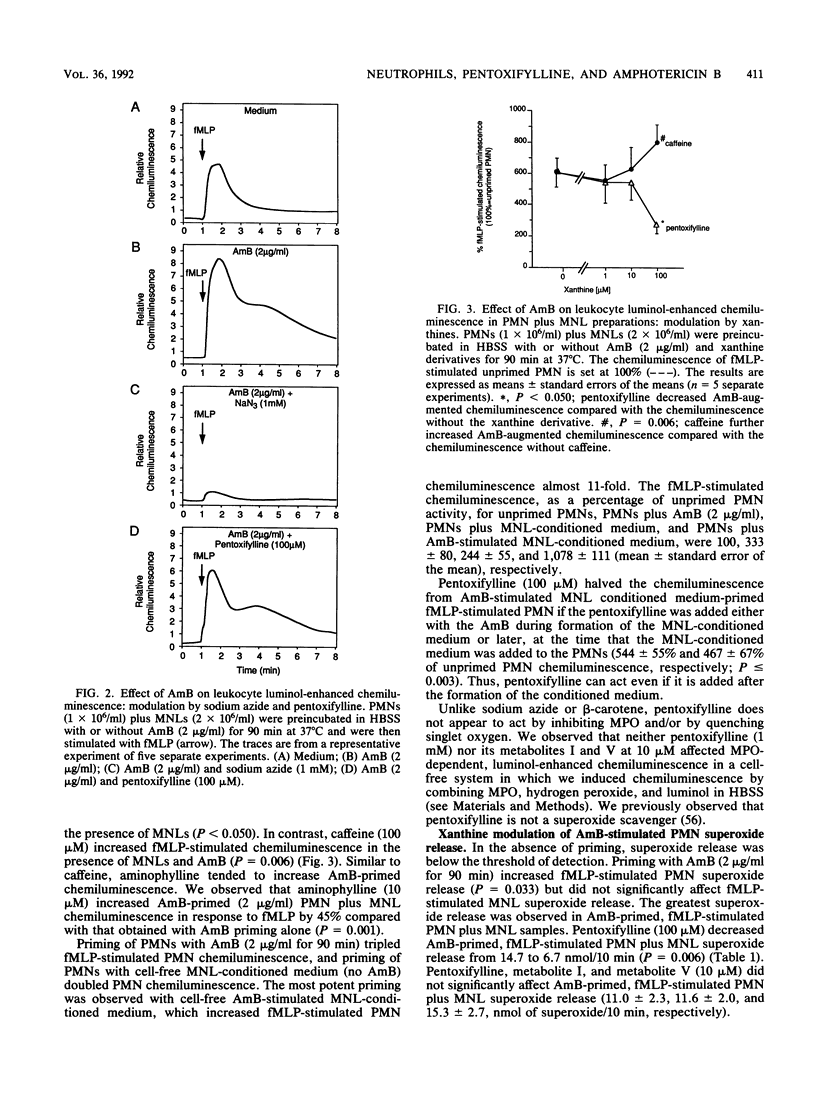
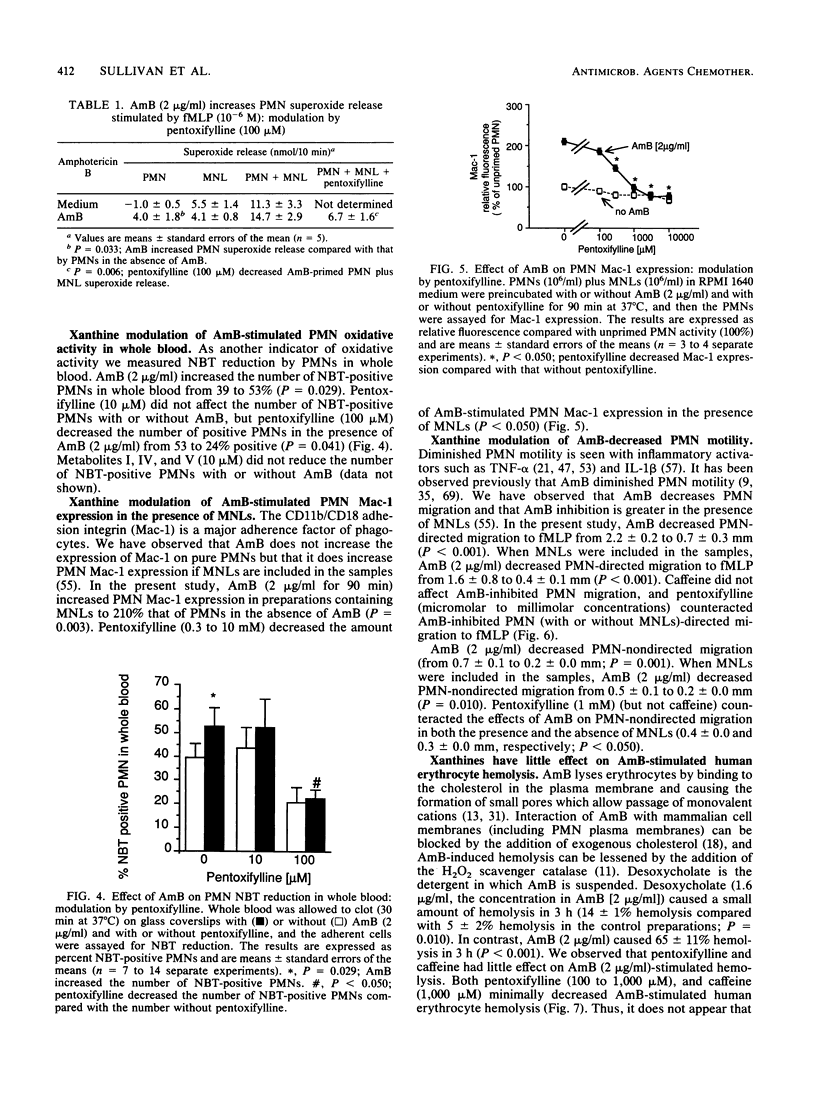
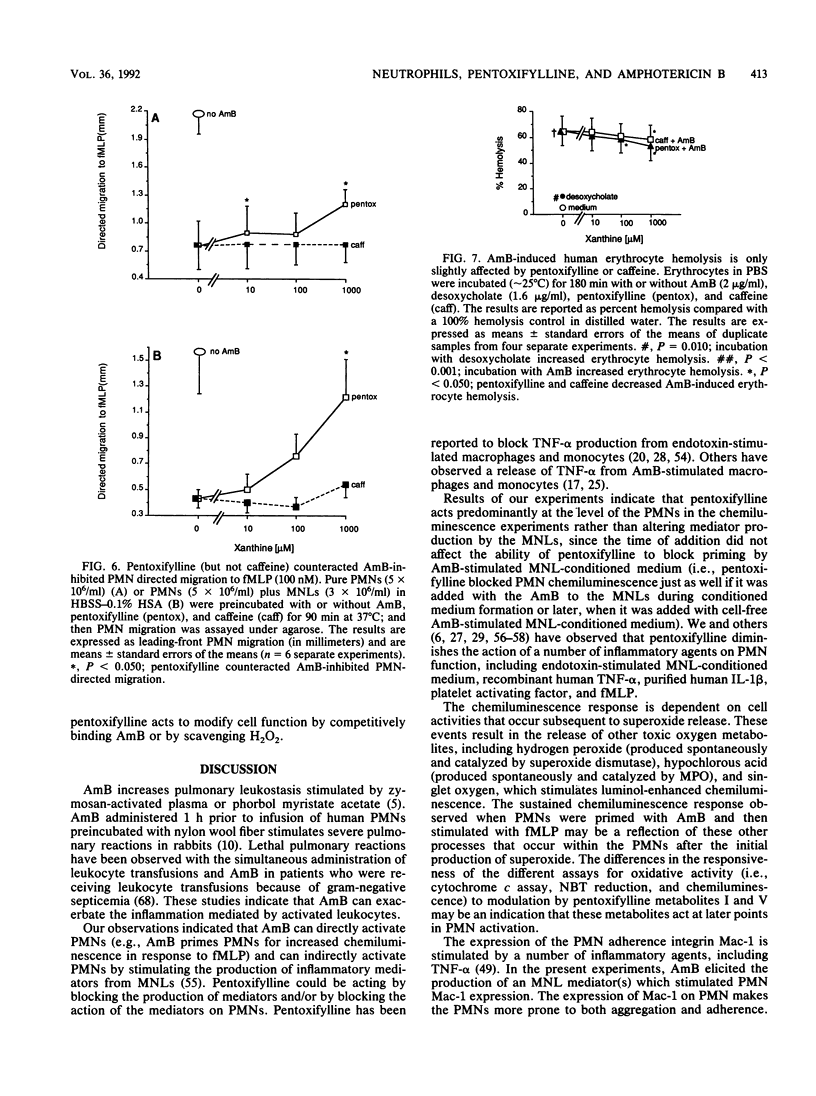
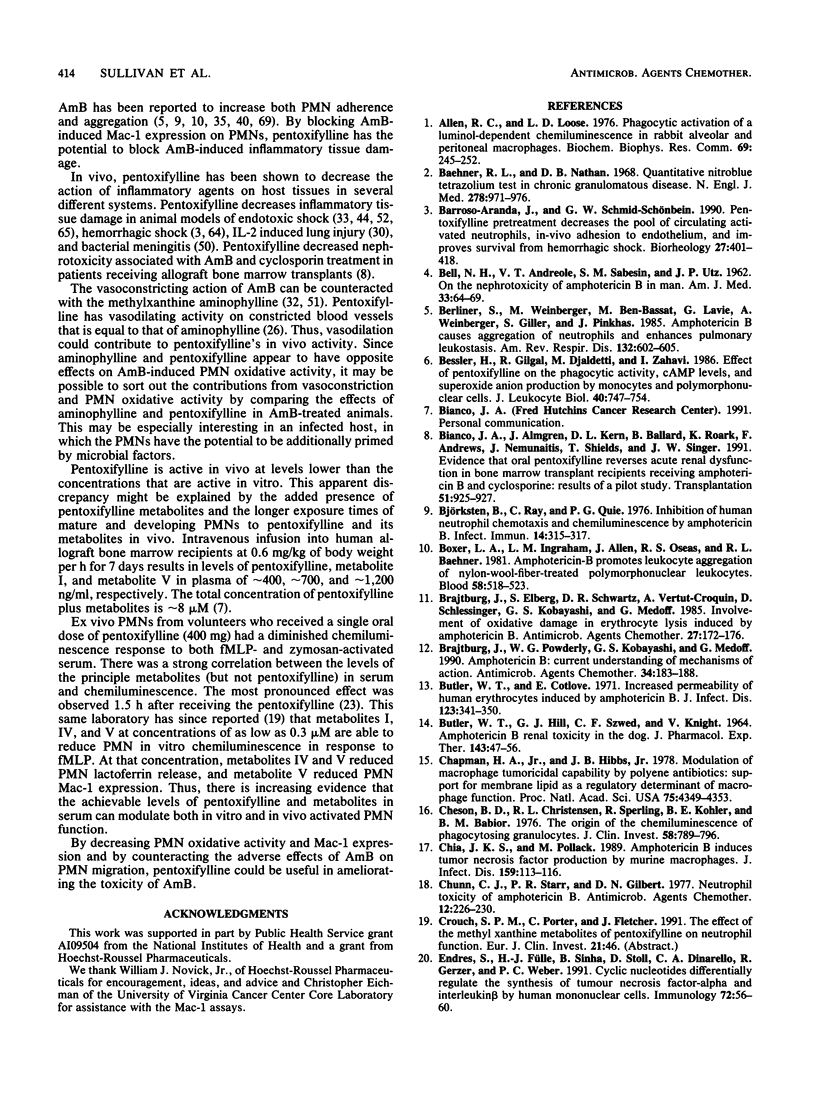
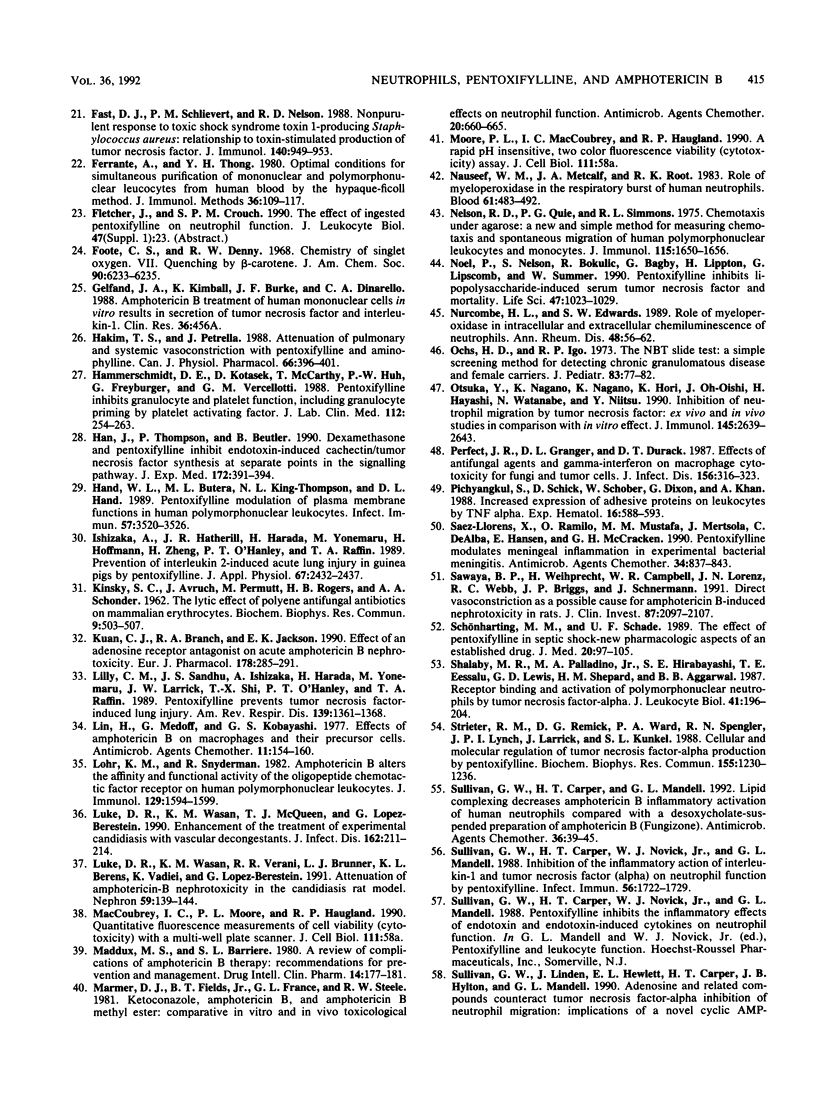
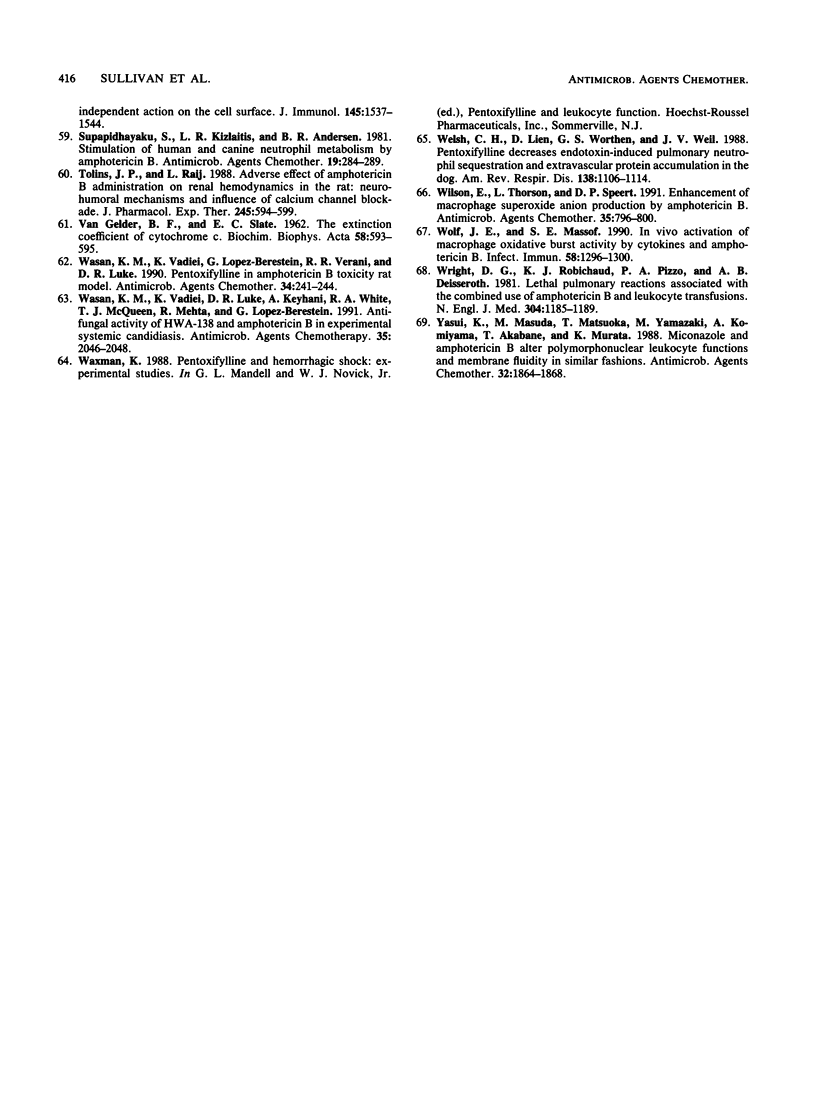
Selected References
These references are in PubMed. This may not be the complete list of references from this article.
- Allen R. C., Loose L. D. Phagocytic activation of a luminol-dependent chemiluminescence in rabbit alveolar and peritoneal macrophages. Biochem Biophys Res Commun. 1976 Mar 8;69(1):245–252. doi: 10.1016/s0006-291x(76)80299-9. [DOI] [PubMed] [Google Scholar]
- BELL N. H., ANDRIOLE V. T., SABESIN S. M., UTZ J. P. On the nephrotoxicity of amphotericin B in man. Am J Med. 1962 Jul;33:64–69. doi: 10.1016/0002-9343(62)90277-2. [DOI] [PubMed] [Google Scholar]
- BUTLER W. T., HILL G. J., 2nd, SZWED C. F., KNIGHT V. AMPHOTERICIN B RENAL TOXICITY IN THE DOG. J Pharmacol Exp Ther. 1964 Jan;143:47–56. [PubMed] [Google Scholar]
- Baehner R. L., Nathan D. G. Quantitative nitroblue tetrazolium test in chronic granulomatous disease. N Engl J Med. 1968 May 2;278(18):971–976. doi: 10.1056/NEJM196805022781801. [DOI] [PubMed] [Google Scholar]
- Barroso-Aranda J., Schmid-Schönbein G. W. Pentoxifylline pretreatment decreases the pool of circulating activated neutrophils, in-vivo adhesion to endothelium, and improves survival from hemorrhagic shock. Biorheology. 1990;27(3-4):401–418. doi: 10.3233/bir-1990-273-417. [DOI] [PubMed] [Google Scholar]
- Berliner S., Weinberger M., Ben-Bassat M., Lavie G., Weinberger A., Giller S., Pinkhas J. Amphotericin B causes aggregation of neutrophils and enhances pulmonary leukostasis. Am Rev Respir Dis. 1985 Sep;132(3):602–605. doi: 10.1164/arrd.1985.132.3.602. [DOI] [PubMed] [Google Scholar]
- Bessler H., Gilgal R., Djaldetti M., Zahavi I. Effect of pentoxifylline on the phagocytic activity, cAMP levels, and superoxide anion production by monocytes and polymorphonuclear cells. J Leukoc Biol. 1986 Dec;40(6):747–754. doi: 10.1002/jlb.40.6.747. [DOI] [PubMed] [Google Scholar]
- Bianco J. A., Almgren J., Kern D. L., Ballard B., Roark K., Andrews F., Nemunaitis J., Shields T., Singer J. W. Evidence that oral pentoxifylline reverses acute renal dysfunction in bone marrow transplant recipients receiving amphotericin B and cyclosporine. Results of a pilot study. Transplantation. 1991 Apr;51(4):925–927. doi: 10.1097/00007890-199104000-00043. [DOI] [PubMed] [Google Scholar]
- Björkstén B., Ray C., Quie P. G. Inhibition of human neutrophil chemotaxis and chemiluminescence by amphotericin B. Infect Immun. 1976 Jul;14(1):315–317. doi: 10.1128/iai.14.1.315-317.1976. [DOI] [PMC free article] [PubMed] [Google Scholar]
- Boxer L. A., Ingraham L. M., Allen J., Oseas R. S., Baehner R. L. Amphotericin-B promotes leukocyte aggregation of nylon-wool-fiber-treated polymorphonuclear leukocytes. Blood. 1981 Sep;58(3):518–523. [PubMed] [Google Scholar]
- Brajtburg J., Elberg S., Schwartz D. R., Vertut-Croquin A., Schlessinger D., Kobayashi G. S., Medoff G. Involvement of oxidative damage in erythrocyte lysis induced by amphotericin B. Antimicrob Agents Chemother. 1985 Feb;27(2):172–176. doi: 10.1128/aac.27.2.172. [DOI] [PMC free article] [PubMed] [Google Scholar]
- Brajtburg J., Powderly W. G., Kobayashi G. S., Medoff G. Amphotericin B: current understanding of mechanisms of action. Antimicrob Agents Chemother. 1990 Feb;34(2):183–188. doi: 10.1128/aac.34.2.183. [DOI] [PMC free article] [PubMed] [Google Scholar]
- Butler W. T., Cotlove E. Increased permeability of human erythrocytes induced by amphotericin B. J Infect Dis. 1971 Apr;123(4):341–350. doi: 10.1093/infdis/123.4.341. [DOI] [PubMed] [Google Scholar]
- Chapman H. A., Jr, Hibbs J. B., Jr Modulation of macrophage tumoricidal capability by polyene antibiotics: support for membrane lipid as a regulatory determinant of macrophage function. Proc Natl Acad Sci U S A. 1978 Sep;75(9):4349–4353. doi: 10.1073/pnas.75.9.4349. [DOI] [PMC free article] [PubMed] [Google Scholar]
- Cheson B. D., Christensen R. L., Sperling R., Kohler B. E., Babior B. M. The origin of the chemiluminescence of phagocytosing granulocytes. J Clin Invest. 1976 Oct;58(4):789–796. doi: 10.1172/JCI108530. [DOI] [PMC free article] [PubMed] [Google Scholar]
- Chia J. K., Pollack M. Amphotericin B induces tumor necrosis factor production by murine macrophages. J Infect Dis. 1989 Jan;159(1):113–116. doi: 10.1093/infdis/159.1.113. [DOI] [PubMed] [Google Scholar]
- Chunn C. J., Starr P. R., Gilbert D. N. Neutrophil toxicity of amphotericin B. Antimicrob Agents Chemother. 1977 Aug;12(2):226–230. doi: 10.1128/aac.12.2.226. [DOI] [PMC free article] [PubMed] [Google Scholar]
- Endres S., Fülle H. J., Sinha B., Stoll D., Dinarello C. A., Gerzer R., Weber P. C. Cyclic nucleotides differentially regulate the synthesis of tumour necrosis factor-alpha and interleukin-1 beta by human mononuclear cells. Immunology. 1991 Jan;72(1):56–60. [PMC free article] [PubMed] [Google Scholar]
- Fast D. J., Schlievert P. M., Nelson R. D. Nonpurulent response to toxic shock syndrome toxin 1-producing Staphylococcus aureus. Relationship to toxin-stimulated production of tumor necrosis factor. J Immunol. 1988 Feb 1;140(3):949–953. [PubMed] [Google Scholar]
- Ferrante A., Thong Y. H. Optimal conditions for simultaneous purification of mononuclear and polymorphonuclear leucocytes from human blood by the Hypaque-Ficoll method. J Immunol Methods. 1980;36(2):109–117. doi: 10.1016/0022-1759(80)90036-8. [DOI] [PubMed] [Google Scholar]
- Hakim T. S., Petrella J. Attenuation of pulmonary and systemic vasoconstriction with pentoxifylline and aminophylline. Can J Physiol Pharmacol. 1988 Apr;66(4):396–401. doi: 10.1139/y88-066. [DOI] [PubMed] [Google Scholar]
- Hammerschmidt D. E., Kotasek D., McCarthy T., Huh P. W., Freyburger G., Vercellotti G. M. Pentoxifylline inhibits granulocyte and platelet function, including granulocyte priming by platelet activating factor. J Lab Clin Med. 1988 Aug;112(2):254–263. [PubMed] [Google Scholar]
- Han J., Thompson P., Beutler B. Dexamethasone and pentoxifylline inhibit endotoxin-induced cachectin/tumor necrosis factor synthesis at separate points in the signaling pathway. J Exp Med. 1990 Jul 1;172(1):391–394. doi: 10.1084/jem.172.1.391. [DOI] [PMC free article] [PubMed] [Google Scholar]
- Hand W. L., Butera M. L., King-Thompson N. L., Hand D. L. Pentoxifylline modulation of plasma membrane functions in human polymorphonuclear leukocytes. Infect Immun. 1989 Nov;57(11):3520–3526. doi: 10.1128/iai.57.11.3520-3526.1989. [DOI] [PMC free article] [PubMed] [Google Scholar]
- Ishizaka A., Hatherill J. R., Harada H., Yonemaru M., Hoffmann H., Zheng H., O'Hanley P. T., Raffin T. A. Prevention of interleukin 2-induced acute lung injury in guinea pigs by pentoxifylline. J Appl Physiol (1985) 1989 Dec;67(6):2432–2437. doi: 10.1152/jappl.1989.67.6.2432. [DOI] [PubMed] [Google Scholar]
- KINSKY S. C., AVRUCH J., PERMUTT M., ROGERS H. B. The lytic effect of polyene antifungal antibiotics on mammalian erythrocytes. Biochem Biophys Res Commun. 1962 Dec 19;9:503–507. doi: 10.1016/0006-291x(62)90116-x. [DOI] [PubMed] [Google Scholar]
- Kuan C. J., Branch R. A., Jackson E. K. Effect of an adenosine receptor antagonist on acute amphotericin B nephrotoxicity. Eur J Pharmacol. 1990 Mar 27;178(3):285–291. doi: 10.1016/0014-2999(90)90107-h. [DOI] [PubMed] [Google Scholar]
- Lilly C. M., Sandhu J. S., Ishizaka A., Harada H., Yonemaru M., Larrick J. W., Shi T. X., O'Hanley P. T., Raffin T. A. Pentoxifylline prevents tumor necrosis factor-induced lung injury. Am Rev Respir Dis. 1989 Jun;139(6):1361–1368. doi: 10.1164/ajrccm/139.6.1361. [DOI] [PubMed] [Google Scholar]
- Lin S. H., Medoff G., Kobayashi G. S. Effects of amphotericin B on macrophages and their precursor cells. Antimicrob Agents Chemother. 1977 Jan;11(1):154–160. doi: 10.1128/aac.11.1.154. [DOI] [PMC free article] [PubMed] [Google Scholar]
- Lohr K. M., Snyderman R. Amphotericin B alters the affinity and functional activity of the oligopeptide chemotactic factor receptor on human polymorphonuclear leukocytes. J Immunol. 1982 Oct;129(4):1594–1599. [PubMed] [Google Scholar]
- Luke D. R., Wasan K. M., McQueen T. J., Lopez-Berestein G. Enhancement of the treatment of experimental candidiasis with vascular decongestants. J Infect Dis. 1990 Jul;162(1):211–214. doi: 10.1093/infdis/162.1.211. [DOI] [PubMed] [Google Scholar]
- Luke D. R., Wasan K. M., Verani R. R., Brunner L. J., Berens K. L., Vadiei K., Lopez-Berestein G. Attenuation of amphotericin-B nephrotoxicity in the candidiasis rat model. Nephron. 1991;59(1):139–144. doi: 10.1159/000186533. [DOI] [PubMed] [Google Scholar]
- Marmer D. J., Fields B. T., Jr, France G. L., Steele R. W. Ketoconazole, amphotericin B, and amphotericin B methyl ester: comparative in vitro and in vivo toxicological effects on neutrophil function. Antimicrob Agents Chemother. 1981 Nov;20(5):660–665. doi: 10.1128/aac.20.5.660. [DOI] [PMC free article] [PubMed] [Google Scholar]
- Nauseef W. M., Metcalf J. A., Root R. K. Role of myeloperoxidase in the respiratory burst of human neutrophils. Blood. 1983 Mar;61(3):483–492. [PubMed] [Google Scholar]
- Nelson R. D., Quie P. G., Simmons R. L. Chemotaxis under agarose: a new and simple method for measuring chemotaxis and spontaneous migration of human polymorphonuclear leukocytes and monocytes. J Immunol. 1975 Dec;115(6):1650–1656. [PubMed] [Google Scholar]
- Noel P., Nelson S., Bokulic R., Bagby G., Lippton H., Lipscomb G., Summer W. Pentoxifylline inhibits lipopolysaccharide-induced serum tumor necrosis factor and mortality. Life Sci. 1990;47(12):1023–1029. doi: 10.1016/0024-3205(90)90474-6. [DOI] [PubMed] [Google Scholar]
- Nurcombe H. L., Edwards S. W. Role of myeloperoxidase in intracellular and extracellular chemiluminescence of neutrophils. Ann Rheum Dis. 1989 Jan;48(1):56–62. doi: 10.1136/ard.48.1.56. [DOI] [PMC free article] [PubMed] [Google Scholar]
- Ochs H. D., Igo R. P. The NBT slide test: a simple screening method for detecting chronic granulomatous disease and female carriers. J Pediatr. 1973 Jul;83(1):77–82. doi: 10.1016/s0022-3476(73)80316-6. [DOI] [PubMed] [Google Scholar]
- Otsuka Y., Nagano K., Nagano K., Hori K., Oh-ishi J., Hayashi H., Watanabe N., Niitsu Y. Inhibition of neutrophil migration by tumor necrosis factor. Ex vivo and in vivo studies in comparison with in vitro effect. J Immunol. 1990 Oct 15;145(8):2639–2643. [PubMed] [Google Scholar]
- Perfect J. R., Granger D. L., Durack D. T. Effects of antifungal agents and gamma interferon on macrophage cytotoxicity for fungi and tumor cells. J Infect Dis. 1987 Aug;156(2):316–323. doi: 10.1093/infdis/156.2.316. [DOI] [PubMed] [Google Scholar]
- Pichyangkul S., Schick D., Schober W., Dixon G., Khan A. Increased expression of adhesive proteins on leukocytes by TNF alpha. Exp Hematol. 1988 Aug;16(7):588–593. [PubMed] [Google Scholar]
- Sawaya B. P., Weihprecht H., Campbell W. R., Lorenz J. N., Webb R. C., Briggs J. P., Schnermann J. Direct vasoconstriction as a possible cause for amphotericin B-induced nephrotoxicity in rats. J Clin Invest. 1991 Jun;87(6):2097–2107. doi: 10.1172/JCI115240. [DOI] [PMC free article] [PubMed] [Google Scholar]
- Schönharting M. M., Schade U. F. The effect of pentoxifylline in septic shock--new pharmacologic aspects of an established drug. J Med. 1989;20(1):97–105. [PubMed] [Google Scholar]
- Shalaby M. R., Palladino M. A., Jr, Hirabayashi S. E., Eessalu T. E., Lewis G. D., Shepard H. M., Aggarwal B. B. Receptor binding and activation of polymorphonuclear neutrophils by tumor necrosis factor-alpha. J Leukoc Biol. 1987 Mar;41(3):196–204. doi: 10.1002/jlb.41.3.196. [DOI] [PubMed] [Google Scholar]
- Strieter R. M., Remick D. G., Ward P. A., Spengler R. N., Lynch J. P., 3rd, Larrick J., Kunkel S. L. Cellular and molecular regulation of tumor necrosis factor-alpha production by pentoxifylline. Biochem Biophys Res Commun. 1988 Sep 30;155(3):1230–1236. doi: 10.1016/s0006-291x(88)81271-3. [DOI] [PubMed] [Google Scholar]
- Sullivan G. W., Carper H. T., Novick W. J., Jr, Mandell G. L. Inhibition of the inflammatory action of interleukin-1 and tumor necrosis factor (alpha) on neutrophil function by pentoxifylline. Infect Immun. 1988 Jul;56(7):1722–1729. doi: 10.1128/iai.56.7.1722-1729.1988. [DOI] [PMC free article] [PubMed] [Google Scholar]
- Supapidhayakul S. R., Kizlaitis L. R., Andersen B. R. Stimulation of human and canine neutrophil metabolism by amphotericin B. Antimicrob Agents Chemother. 1981 Feb;19(2):284–289. doi: 10.1128/aac.19.2.284. [DOI] [PMC free article] [PubMed] [Google Scholar]
- Sáez-Llorens X., Ramilo O., Mustafa M. M., Mertsola J., de Alba C., Hansen E., McCracken G. H., Jr Pentoxifylline modulates meningeal inflammation in experimental bacterial meningitis. Antimicrob Agents Chemother. 1990 May;34(5):837–843. doi: 10.1128/aac.34.5.837. [DOI] [PMC free article] [PubMed] [Google Scholar]
- Tolins J. P., Raij L. Adverse effect of amphotericin B administration on renal hemodynamics in the rat. Neurohumoral mechanisms and influence of calcium channel blockade. J Pharmacol Exp Ther. 1988 May;245(2):594–599. [PubMed] [Google Scholar]
- Wasan K. M., Vadiei K., Lopez-Berestein G., Verani R. R., Luke D. R. Pentoxifylline in amphotericin B toxicity rat model. Antimicrob Agents Chemother. 1990 Feb;34(2):241–244. doi: 10.1128/aac.34.2.241. [DOI] [PMC free article] [PubMed] [Google Scholar]
- Wasan K. M., Vadiei K., Luke D. R., Keyhani A., White R. A., McQueen T. J., Mehta R., Lopez-Berestein G. Antifungal activity of HWA-138 and amphotericin B in experimental systemic candidiasis. Antimicrob Agents Chemother. 1991 Oct;35(10):2046–2048. doi: 10.1128/aac.35.10.2046. [DOI] [PMC free article] [PubMed] [Google Scholar]
- Welsh C. H., Lien D., Worthen G. S., Weil J. V. Pentoxifylline decreases endotoxin-induced pulmonary neutrophil sequestration and extravascular protein accumulation in the dog. Am Rev Respir Dis. 1988 Nov;138(5):1106–1114. doi: 10.1164/ajrccm/138.5.1106. [DOI] [PubMed] [Google Scholar]
- Wilson E., Thorson L., Speert D. P. Enhancement of macrophage superoxide anion production by amphotericin B. Antimicrob Agents Chemother. 1991 May;35(5):796–800. doi: 10.1128/aac.35.5.796. [DOI] [PMC free article] [PubMed] [Google Scholar]
- Wolf J. E., Massof S. E. In vivo activation of macrophage oxidative burst activity by cytokines and amphotericin B. Infect Immun. 1990 May;58(5):1296–1300. doi: 10.1128/iai.58.5.1296-1300.1990. [DOI] [PMC free article] [PubMed] [Google Scholar]
- Wright D. G., Robichaud K. J., Pizzo P. A., Deisseroth A. B. Lethal pulmonary reactions associated with the combined use of amphotericin B and leukocyte transfusions. N Engl J Med. 1981 May 14;304(20):1185–1189. doi: 10.1056/NEJM198105143042001. [DOI] [PubMed] [Google Scholar]
- Yasui K., Masuda M., Matsuoka T., Yamazaki M., Komiyama A., Akabane T., Murata K. Miconazole and amphotericin B alter polymorphonuclear leukocyte functions and membrane fluidity in similar fashions. Antimicrob Agents Chemother. 1988 Dec;32(12):1864–1868. doi: 10.1128/aac.32.12.1864. [DOI] [PMC free article] [PubMed] [Google Scholar]
- van GELDER B., SLATER E. C. The extinction coefficient of cytochrome c. Biochim Biophys Acta. 1962 Apr 23;58:593–595. doi: 10.1016/0006-3002(62)90073-2. [DOI] [PubMed] [Google Scholar]


